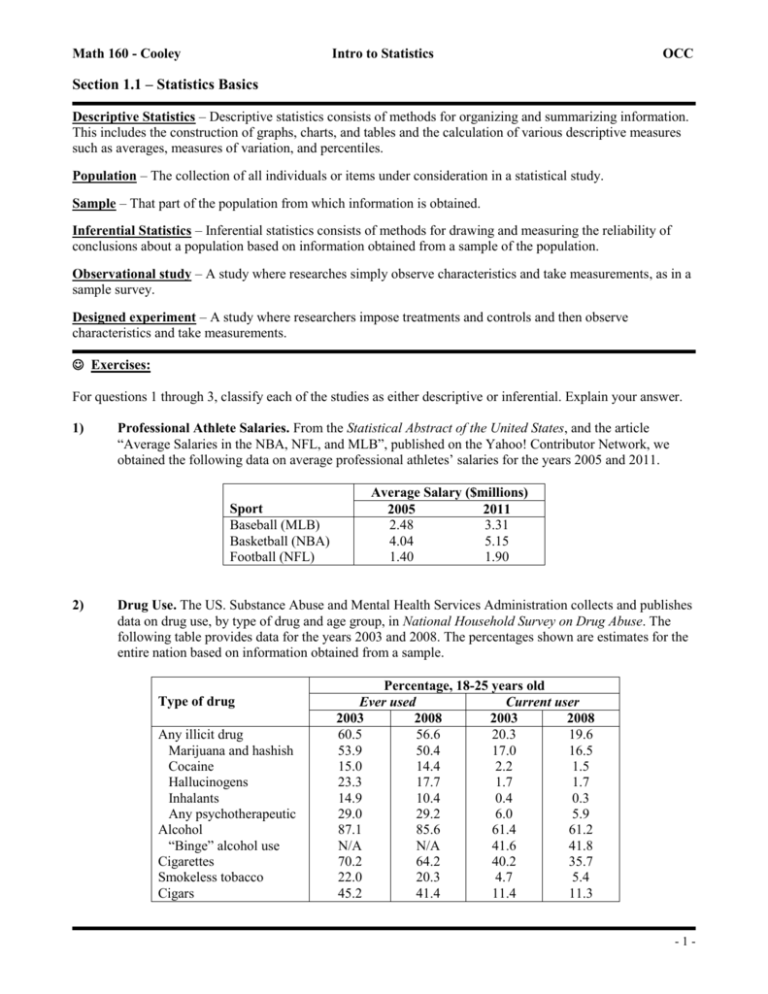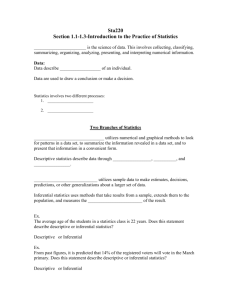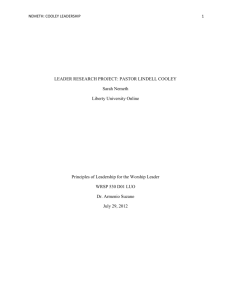Math 160 - Section 1.1
advertisement

Math 160 - Cooley Intro to Statistics OCC Section 1.1 – Statistics Basics Descriptive Statistics – Descriptive statistics consists of methods for organizing and summarizing information. This includes the construction of graphs, charts, and tables and the calculation of various descriptive measures such as averages, measures of variation, and percentiles. Population – The collection of all individuals or items under consideration in a statistical study. Sample – That part of the population from which information is obtained. Inferential Statistics – Inferential statistics consists of methods for drawing and measuring the reliability of conclusions about a population based on information obtained from a sample of the population. Observational study – A study where researches simply observe characteristics and take measurements, as in a sample survey. Designed experiment – A study where researchers impose treatments and controls and then observe characteristics and take measurements. Exercises: For questions 1 through 3, classify each of the studies as either descriptive or inferential. Explain your answer. 1) Professional Athlete Salaries. From the Statistical Abstract of the United States, and the article “Average Salaries in the NBA, NFL, and MLB”, published on the Yahoo! Contributor Network, we obtained the following data on average professional athletes’ salaries for the years 2005 and 2011. Sport Baseball (MLB) Basketball (NBA) Football (NFL) 2) Average Salary ($millions) 2005 2011 2.48 3.31 4.04 5.15 1.40 1.90 Drug Use. The US. Substance Abuse and Mental Health Services Administration collects and publishes data on drug use, by type of drug and age group, in National Household Survey on Drug Abuse. The following table provides data for the years 2003 and 2008. The percentages shown are estimates for the entire nation based on information obtained from a sample. Type of drug Any illicit drug Marijuana and hashish Cocaine Hallucinogens Inhalants Any psychotherapeutic Alcohol “Binge” alcohol use Cigarettes Smokeless tobacco Cigars Percentage, 18-25 years old Ever used Current user 2003 2008 2003 2008 60.5 56.6 20.3 19.6 53.9 50.4 17.0 16.5 15.0 14.4 2.2 1.5 23.3 17.7 1.7 1.7 14.9 10.4 0.4 0.3 29.0 29.2 6.0 5.9 87.1 85.6 61.4 61.2 N/A N/A 41.6 41.8 70.2 64.2 40.2 35.7 22.0 20.3 4.7 5.4 45.2 41.4 11.4 11.3 -1- Math 160 - Cooley Intro to Statistics OCC Section 1.1 – Statistics Basics Exercises: 3) The Music People Buy. Results of monthly telephone surveys yielded in the percentage estimates of all music expenditures shown in the following table. These statistics were published in 2007 Consumer Profile. [SOURCE: Recording Industry Association of America, Inc.] Music Type Rock R&B/Urban Country Rap/Hip-Hop Pop Other Religious Children’s Jazz Unknown Classical Soundtracks Oldies New Age 4) 5) Expenditure (%) 32.4 11.8 11.5 10.8 10.7 7.1 3.9 2.9 2.6 2.5 2.3 0.8 0.4 0.3 Pricey Gasoline. An Associated Press / AOL pool of 1000 U.S. adults, taken April 18-20, 2005 and appearing in the Eau Claire Leader Telegram on April 22, asked about some of the consequences of the rising cost of gasoline. Of those sampled, 58% had reduced their driving, 57% had cut back on other expenses, 41% had planned vacations closer to home, and 41% said that they may buy a more fuel-efficient vehicle. a) Identify the population and sample for this study. b) Are the percentages provided descriptive statistics or inferential statistics? Explain your answer. Do Left-Handers Die Earlier? According to a study published in the Journal of the American Public Health Association, left-handed people do not die at an earlier age than right-handed people, contrary to the conclusion of a highly publicized report done 2 years earlier. The investigation involved a 6-year study of 3800 people in East Boston older than age 65. Researchers at Harvard University and the National Institute of Aging found that the “lefties” and “righties” died at exactly the same rate. “There was no difference, period,” said Dr. Jack Guralnik, an epidemiologist at the institute and one of the coauthors of the report. Is this investigation an observational study or a designed experiment? Justify your answer. -2- Math 160 - Cooley Intro to Statistics OCC Section 1.1 – Statistics Basics Exercises: 6) Aspirin and Cardiovascular Disease. In an article by P. Ridker et al. titled “A Randomized Trial of Low-dose Aspirin in the Primary Prevention of Cardiovascular Disease in Women” (New England Journal of Medicine, Vol. 352, pp. 1293-1304), the researchers noted that “We randomly assigned 39,876 initially healthy women 45 years of age or older to receive 100 mg of aspirin or placebo on alternate days and then monitored them for 10 years for a first major cardiovascular event (i.e., nonfat myocardial infraction, nonfatal stroke, or death from cardiovascular causes).” Is this investigation a designed experiment or an observational study? Explain your answer. 7) Starting Salaries. The National Association of Colleges and Employees (NACE) compiles information on salary offers to new college graduates and publishes the results in Salary Survey. Are these statistical studies designed experiments or observational studies? Explain your answer. Answers to Exercises: 1) Descriptive; It is a summary of the average salaries in professional baseball, basketball, and football for 2005 and 2011. 2) Inferential; National samples are used to make estimates (or inferences about) drug use through the entire nation. 3) Inferential; Monthly survey data is used to make estimates of the percentages of all music expenditures. 4a) The population consists of all U.S. adults. The sample consists of the 1000 U.S. adults who were surveyed. 4b) The percentages provided are descriptive statistics since they described the consequences of higher gasoline prices for the 1000 people surveyed. There does not seem to be an attempt to claim that these percentages apply to the entire population of the U.S. 5) Observational Study; The researchers at Harvard University and the National Institute of Aging simply observed the two groups. 6) Designed Experiment; The researchers did not simply observe the two groups of women, but instead randomly assigned one group to receive aspirin and the other to get a placebo. 7) Observation Studies; The researchers simply collected available information about the starting salaries of new college graduates. -3-











